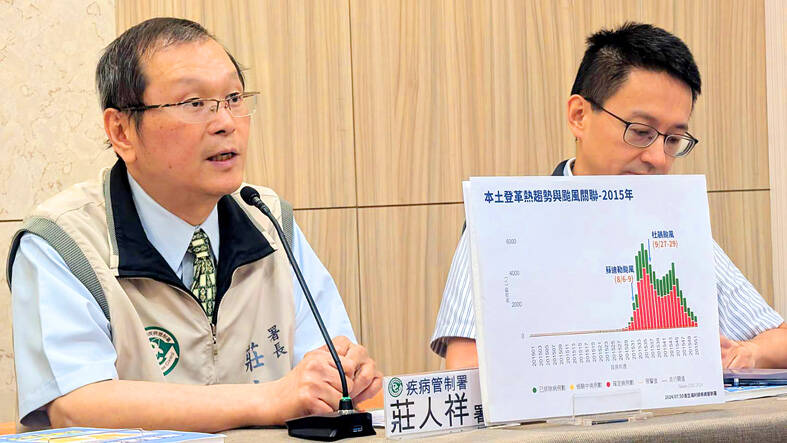Three new cases of whooping cough were reported in northern Taiwan last week, the Centers for Disease Control (CDC) said yesterday, as it reported 584 new COVID-19 hospitalizations and 90 deaths.
CDC Epidemic Intelligence Center Deputy Director Lee Chia-lin (李佳琳) said the three new cases of pertussis, commonly known as whooping cough, are members of the same family, who began experiencing respiratory symptoms early last month.
“During contact tracing, [a young man’s] father and sister were found to have symptoms, and both tested positive for whooping cough,” Lee said.

Photo: CNA
A total of 16 cases have been reported this year, including 11 from four family clusters, she said, adding that the accumulated number is the highest for the period in five years.
CDC physician Lin Yung-ching (林詠青) said the young man does not have an underlying health condition, but had not been vaccinated against whooping cough.
He began coughing early last month, but only sought traditional Chinese medicine treatment for his serious coughing, a high-pitched sound when breathing and apnea, Lin said.
In the middle of this month, he went to a hospital, where a doctor tested him for whooping cough, which came back positive on Tuesday last week, he said.
It had been about seven weeks from the onset of his symptoms to diagnosis, he said.
While two of his family members were also confirmed with whooping cough, 37 close contacts at the school he attends did not have symptoms, but postexposure prophylaxis would be administered, and contact tracing would be expanded, he said.
“Whooping cough is highly contagious among unvaccinated people,” CDC Deputy Director-General Philip Lo (羅一鈞) said, adding that in some cases one person could transmit it to up to 17 people.
Whooping cough has a reproductive number (R0) of 15 to 17, with R0 being the average number of people that one infected individual could infect in a susceptible (unvaccinated) population, he said.
The father and sister of the infected person tested positive yesterday morning, so contact tracing is ongoing, Lo said.
“As recent cases of whooping cough had been diagnosed relatively late after their symptoms had started, there are risks of outbreak in the local communities,” he said.
“We urge people to see a doctor if they are experiencing prolonged coughing, and we also remind doctors to promptly test and report suspected cases, as the risk of local infection is increasing,” he added.
As vaccination is the best protection against whooping cough, parents of young children should have them get a five-dose pertussis-containing vaccine, which is part of the CDC’s recommended vaccination schedule before children enter elementary school, Lo said.
Meanwhile, the 584 new local COVID-19 hospitalizations and 90 deaths reported last week were lower than the weekly numbers in the previous week, Lee said.
Genome sequencing data of local infections in the past four weeks showed that the JN.1 and KP.3 subvariants of SARS-CoV-2 each accounted for 24 percent of the cases, while LB.1 was responsible for about 21 percent, she said.
The weekly number of COVID-19 hospitalizations has fallen for three weeks, but last week’s drop could be because the typhoon caused the cancelation of many public events and people to stay home, so it might slightly rebound this week, Lo said.
The current epidemic period is expected to end by the second half of next month, he added.

Taiwan is stepping up plans to create self-sufficient supply chains for combat drones and increase foreign orders from the US to counter China’s numerical superiority, a defense official said on Saturday. Commenting on condition of anonymity, the official said the nation’s armed forces are in agreement with US Admiral Samuel Paparo’s assessment that Taiwan’s military must be prepared to turn the nation’s waters into a “hellscape” for the Chinese People’s Liberation Army (PLA). Paparo, the commander of the US Indo-Pacific Command, reiterated the concept during a Congressional hearing in Washington on Wednesday. He first coined the term in a security conference last

Prosecutors today declined to say who was questioned regarding alleged forgery on petitions to recall Democratic Progressive Party (DPP) legislators, after Chinese-language media earlier reported that members of the Chinese Nationalist Party (KMT) Youth League were brought in for questioning. The Ministry of Justice Investigation Bureau confirmed that two people had been questioned, but did not disclose any further information about the ongoing investigation. KMT Youth League members Lee Hsiao-liang (李孝亮) and Liu Szu-yin (劉思吟) — who are leading the effort to recall DPP caucus chief executive Rosalia Wu (吳思瑤) and Legislator Wu Pei-yi (吳沛憶) — both posted on Facebook saying: “I

Sung Chien-liang (宋建樑), who led efforts to recall Democratic Progressive Party (DPP) Legislator Lee Kun-cheng (李坤城), was released on bail of NT$80,000 today amid outcry over his decision to wear a Nazi armband to questioning the night before. Sung arrived at the New Taipei District Prosecutors’ Office for questioning in a recall petition forgery case last night wearing a red armband bearing a swastika, carrying a copy of Adolf Hitler’s Mein Kampf and giving a Nazi salute. Sung left the building at 1:15am without the armband and covering the book with his coat. Lee said today that this is a serious

The Ministry of Economic Affairs has fined Taobao NT$1.2 million (US$36,912) for advertisements that exceed its approved business scope, requiring the Chinese e-commerce platform to make corrections in the first half of this year or its license may be revoked. Lawmakers have called for stricter enforcement of Chinese e-commerce platforms and measures to prevent China from laundering its goods through Taiwan in response to US President Donald Trump’s heavy tariffs on China. The Legislative Yuan’s Finance Committee met today to discuss policies to prevent China from dumping goods in Taiwan, inviting government agencies to report. Democratic Progressive Party Legislator Kuo Kuo-wen (郭國文) said